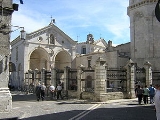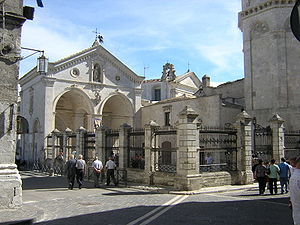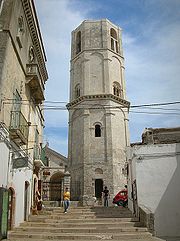
Sanctuary of Monte Sant'Angelo
Encyclopedia


Gargano
Gargano is a historical and geographical Italian sub-region situated in Apulia, consisting of a wide isolated mountain massif made of highland and several peaks and forming the backbone of the Gargano Promontory projecting into the Adriatic Sea. The high point is Monte Calvo at . Most of the upland...
, Italy
Italy
Italy , officially the Italian Republic languages]] under the European Charter for Regional or Minority Languages. In each of these, Italy's official name is as follows:;;;;;;;;), is a unitary parliamentary republic in South-Central Europe. To the north it borders France, Switzerland, Austria and...
, part of the commune of Monte Sant'Angelo
Monte Sant'Angelo
Monte Sant'Angelo is a town and comune of Apulia, southern Italy, in the province of Foggia, about 15 km north of Manfredonia by road and 4 km west of Mattinata, on the southern slopes of Monte Gargano.-History:...
, in the province of Foggia
Province of Foggia
The Province of Foggia is a province in the Apulia region of Italy.This province is also known as Capitanata, originally Catapanata, because during the Middle Ages it was governed by a catapan, as part of the Catapanate of Italy...
, northern Apulia
Apulia
Apulia is a region in Southern Italy bordering the Adriatic Sea in the east, the Ionian Sea to the southeast, and the Strait of Òtranto and Gulf of Taranto in the south. Its most southern portion, known as Salento peninsula, forms a high heel on the "boot" of Italy. The region comprises , and...
.
It is the oldest shrine in Western Europe
Western Europe
Western Europe is a loose term for the collection of countries in the western most region of the European continents, though this definition is context-dependent and carries cultural and political connotations. One definition describes Western Europe as a geographic entity—the region lying in the...
dedicated to the archangel Michael
Michael (archangel)
Michael , Micha'el or Mîkhā'ēl; , Mikhaḗl; or Míchaël; , Mīkhā'īl) is an archangel in Jewish, Christian, and Islamic teachings. Roman Catholics, Anglicans, and Lutherans refer to him as Saint Michael the Archangel and also simply as Saint Michael...
and has been an important pilgrimage site since the middle ages. The historic site and its environs are protected by the Parco Nazionale del Gargano
Gargano
Gargano is a historical and geographical Italian sub-region situated in Apulia, consisting of a wide isolated mountain massif made of highland and several peaks and forming the backbone of the Gargano Promontory projecting into the Adriatic Sea. The high point is Monte Calvo at . Most of the upland...
.
In 2011, it became a UNESCO World Heritage Site as part of a group of seven inscribed as Longobards in Italy. Places of the power (568-774 A.D.).
History
The legend of the Archangel's apparition at Gargano is related in the Roman BreviaryBreviary
A breviary is a liturgical book of the Latin liturgical rites of the Catholic Church containing the public or canonical prayers, hymns, the Psalms, readings, and notations for everyday use, especially by bishops, priests, and deacons in the Divine Office...
for May 8, as well as in the Golden Legend
Golden Legend
The Golden Legend is a collection of hagiographies by Jacobus de Voragine that became a late medieval bestseller. More than a thousand manuscripts of the text have survived, compared to twenty or so of its nearest rivals...
(Legenda Aurea), the compendium of Christian mythology
Christian mythology
Christian mythology is the body of myths associated with Christianity. In the study of mythology, the term "myth" refers to a traditional story, often one which is regarded as sacred and which explains how the world and its inhabitants came to have their present form.Classicist G.S. Kirk defines a...
compiled by Jacobus de Voragine
Jacobus de Voragine
Blessed Jacobus de Varagine or Voragine was an Italian chronicler and archbishop of Genoa. He was the author, or more accurately the compiler, of Legenda Aurea, the Golden Legend, a collection of the legendary lives of the greater saints of the medieval church that was one of the most popular...
between 1260-1275.
According to this legend, around the year 490 the Archangel Michael appeared several times to the Bishop of Sipontum
Siponto
Siponto was an ancient port town of Apulia in southern Italy. The town was abandoned after earthquakes in the 13th century; today the area is administered as a frazione of the comune of Manfredonia, in the province of Foggia...
near a cave, asking that the cave be dedicated to Christian worship and promising protection of the nearby town of Sipontum from pagan invaders. These were the first apparitions of Michael in Western Europe.
Pope Gelasius I (reigned 492-496) directed that a basilica
Basilica
The Latin word basilica , was originally used to describe a Roman public building, usually located in the forum of a Roman town. Public basilicas began to appear in Hellenistic cities in the 2nd century BC.The term was also applied to buildings used for religious purposes...
be erected enclosing the space. The Basilica di San Giovanni in Tumba is the final resting-place of the Lombard
Lombards
The Lombards , also referred to as Longobards, were a Germanic tribe of Scandinavian origin, who from 568 to 774 ruled a Kingdom in Italy...
king Rothari
Rothari
Rothari , of the house of Arodus, was king of the Lombards from 636 to 652; previously he had been duke of Brescia. He succeeded Arioald, who was an Arian like himself, and was one of the most energetic of Lombard kings...
(died 652); the designation "tumba" is now applied to the cupola on squinches.
To Michael's dramatic later intercession, appearing with flaming sword atop the mountain, in the midst of a storm on the eve of the battle, the Lombards of Sipontum attributed their victory (May 8, 663) over the Greeks loyal to the Byzantine emperor
Byzantine Empire
The Byzantine Empire was the Eastern Roman Empire during the periods of Late Antiquity and the Middle Ages, centred on the capital of Constantinople. Known simply as the Roman Empire or Romania to its inhabitants and neighbours, the Empire was the direct continuation of the Ancient Roman State...
, and so, in commemoration of this victory, the church of Sipontum instituted a special feast honoring the Archangel, on May 8, which then spread throughout the Catholic Church. Since the time of Pius V it has been formalized as Apparitio S. Michaelis although it originally did not commemorate the apparition, but the victory of the barbarian Lombards over the Orthodox Greeks.
Architecture
The complex of buildings consists of the Battistero di San Giovanni in Tumba, damaged in 1942, and the Church of Santa Maria Maggiore. The baptisteryBaptistery
In Christian architecture the baptistry or baptistery is the separate centrally-planned structure surrounding the baptismal font. The baptistry may be incorporated within the body of a church or cathedral and be provided with an altar as a chapel...
presents a rectangular storey on which rests an octagon supporting an elliptical section and a high drum that supports the cupola. The church erected in the eleventh century by Archbishop Leone stands upon the remains of an ancient necropolis
Necropolis
A necropolis is a large cemetery or burial ground, usually including structural tombs. The word comes from the Greek νεκρόπολις - nekropolis, literally meaning "city of the dead"...
. A few remnants attest to its once-rich fresco
Fresco
Fresco is any of several related mural painting types, executed on plaster on walls or ceilings. The word fresco comes from the Greek word affresca which derives from the Latin word for "fresh". Frescoes first developed in the ancient world and continued to be popular through the Renaissance...
decoration.
The Castello was enlarged by the Normans
Normans
The Normans were the people who gave their name to Normandy, a region in northern France. They were descended from Norse Viking conquerors of the territory and the native population of Frankish and Gallo-Roman stock...
upon an episcopal residence of Orso, Bishop of Benevento, to provide a suitable seat for the Honor Montis Sancti Angeli, further modified by Frederick II
Frederick II, Holy Roman Emperor
Frederick II , was one of the most powerful Holy Roman Emperors of the Middle Ages and head of the House of Hohenstaufen. His political and cultural ambitions, based in Sicily and stretching through Italy to Germany, and even to Jerusalem, were enormous...
. The massive, octagonal campanile
Campanile
Campanile is an Italian word meaning "bell tower" . The term applies to bell towers which are either part of a larger building or free-standing, although in American English, the latter meaning has become prevalent.The most famous campanile is probably the Leaning Tower of Pisa...
was built in the late 13th century by Frederick II as a watchtower. It was turned into a bell tower by Charles I of Anjou.
Behind a forecourt the sanctuary presents a portico of two Gothic arches, the right one of 1395 by the local architect Simone, the left one a reconstruction of 1865. From the portico steps lead down to the low arched nave. The cavern can be accessed from a Romanesque
Romanesque architecture
Romanesque architecture is an architectural style of Medieval Europe characterised by semi-circular arches. There is no consensus for the beginning date of the Romanesque architecture, with proposals ranging from the 6th to the 10th century. It developed in the 12th century into the Gothic style,...
portal, called the Portale del Toro ("Gate of the Bull"): the doors, in bronze, were made in Constantinople in 1076, the donation of an Amalfi
Amalfi
Amalfi is a town and comune in the province of Salerno, in the region of Campania, Italy, on the Gulf of Salerno, c. 35 km southeast of Naples. It lies at the mouth of a deep ravine, at the foot of Monte Cerreto , surrounded by dramatic cliffs and coastal scenery...
tan noble. They are divided in 24 panels portraying episodes of angels from the Old and New Testaments.
The archaic cavern opening to the left, with its holy well, is full of votive offering
Votive offering
A votive deposit or votive offering is one or more objects displayed or deposited, without the intention of recovery or use, in a sacred place for broadly religious purposes. Such items are a feature of modern and ancient societies and are generally made in order to gain favor with supernatural...
s, especially the 12th century marble bishop's throne supported on crouching lions. Among the ex voto objects is a statue of the Archangel by Andrea Sansovino
Andrea Sansovino
Andrea dal Monte Sansovino or Andrea Contucci del Monte San Savino was an Italian sculptor active during the High Renaissance...
.
Pilgrimages
During centuries, millions of pilgrims went to Monte Sant'Angelo in order to visit the “Celestial Basilica”. Among the pilgrims who visited the Saint Michael Archangel Sanctuary were many popes (Gelasius I, Leo IX, Urban II, Alexander III, Gregory X, Celestine V, John XXIII as Cardinal, John Paul II), saints (Bridget of SwedenBridget of Sweden
Bridget of Sweden Bridget of Sweden Bridget of Sweden (1303 – 23 July 1373; also Birgitta of Vadstena, Saint Birgitta , was a mystic and saint, and founder of the Bridgettines nuns and monks after the death of her husband of twenty years...
, Bernard of Clairvaux
Bernard of Clairvaux
Bernard of Clairvaux, O.Cist was a French abbot and the primary builder of the reforming Cistercian order.After the death of his mother, Bernard sought admission into the Cistercian order. Three years later, he was sent to found a new abbey at an isolated clearing in a glen known as the Val...
, Thomas Aquinas
Thomas Aquinas
Thomas Aquinas, O.P. , also Thomas of Aquin or Aquino, was an Italian Dominican priest of the Catholic Church, and an immensely influential philosopher and theologian in the tradition of scholasticism, known as Doctor Angelicus, Doctor Communis, or Doctor Universalis...
) emperors, kings and princes (Louis II of Italy, Otto III, Herny II, Matilda of Tuscany, Charles I of Naples, Ferdinand II of Aragon).
Also Francis of Assisi
Francis of Assisi
Saint Francis of Assisi was an Italian Catholic friar and preacher. He founded the men's Franciscan Order, the women’s Order of St. Clare, and the lay Third Order of Saint Francis. St...
went to visit the Sanctuary, but feeling himself unworthy to enter the grotto, he stopped in prayer and meditation at the entrance, kissed and carved on a stone the sign of the cross in the form of “T” (tau).
The guardians
Since 13 July 1996, the pastoral care of Saint Michael Archangel Sanctuary has been given to the Congregation of Saint Michael the ArchangelCongregation of Saint Michael the Archangel
The Congregation of Saint Michael the Archangel , in Latin Congregatio Sancti Michaëlis Archangeli and also known as the Michaelite Fathers, is a religious order of the Roman Catholic Church founded in 1897 by the Blessed Father Bronisław Markiewicz, a Polish priest from Miejsce Piastowe, Poland...
.
External links
- ildiariomontanaro.it - la testata giornalistica di Monte Sant'Angelo, a cura dell'associazione culturale Obiettivo Gargano.
- santuariosanmichele.it
- Jacopus de Voragine, Golden Legend: Saint Michael
- Selected modern bibliography
- Virtual tour of the Sanctuary
- Monte Sant’Angelo & the Gargano Photos

